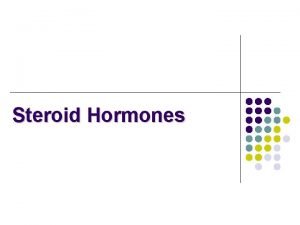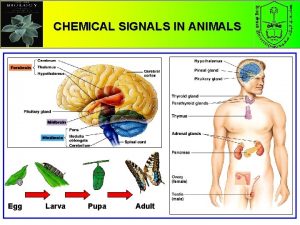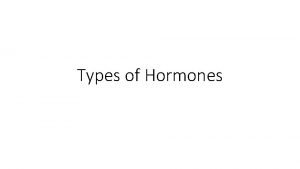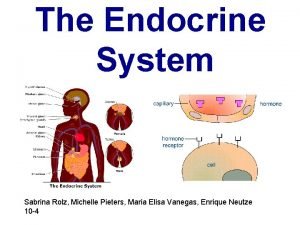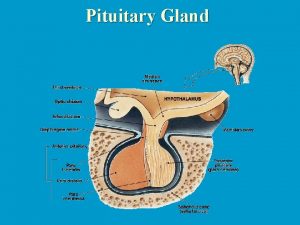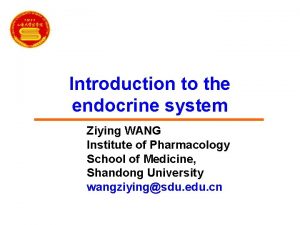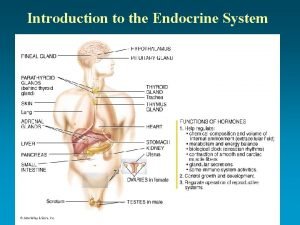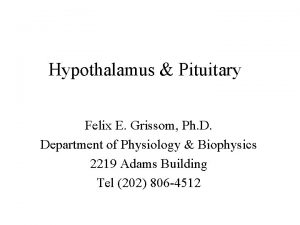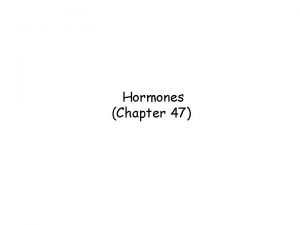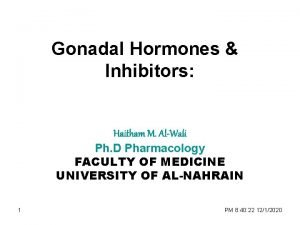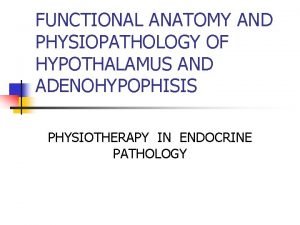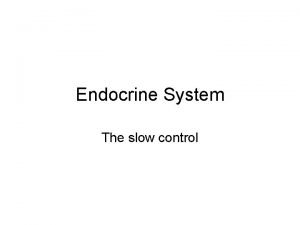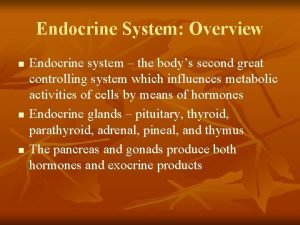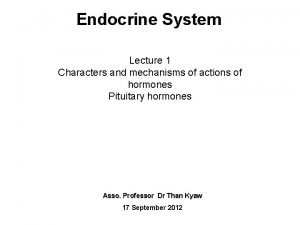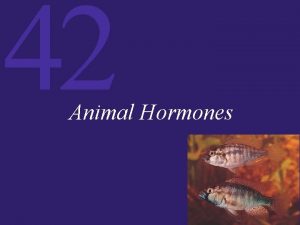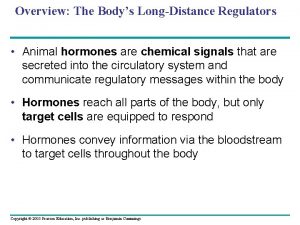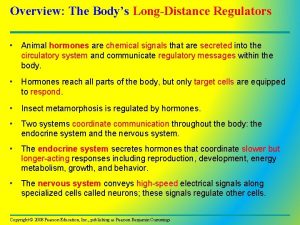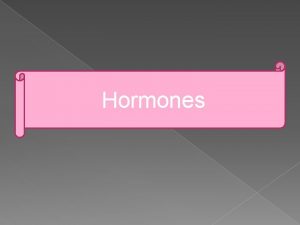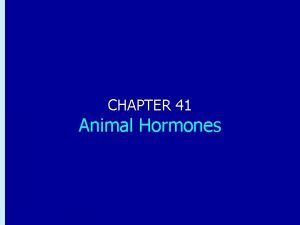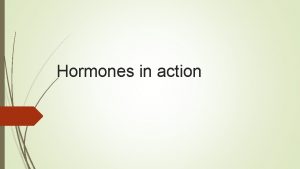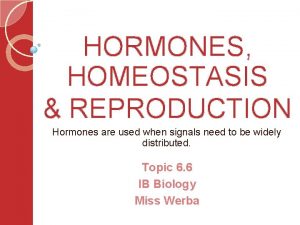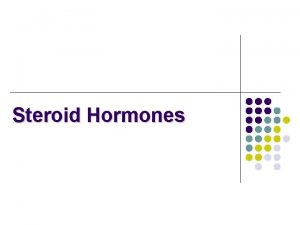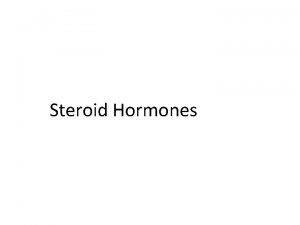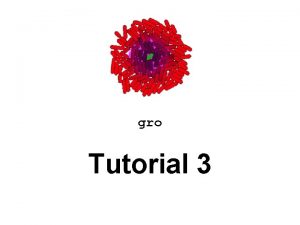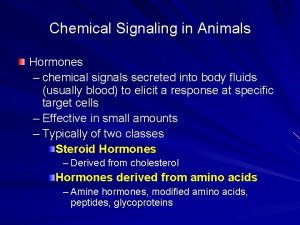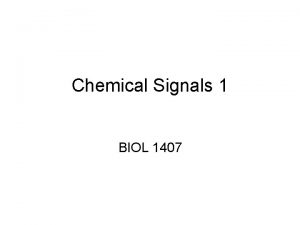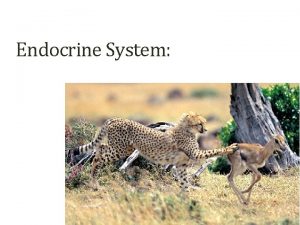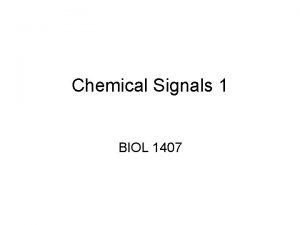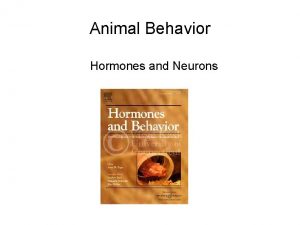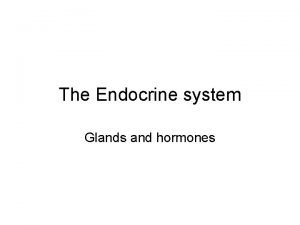Hormones LongDistance Chemical Signals Animal hormones are chemical




























- Slides: 28

Hormones = Long-Distance Chemical Signals ▪ Animal hormones are chemical signals that are secreted into the circulatory system and communicate regulatory messages within the body ▪ Hormones reach all parts of the body, but only target cells have receptors for that hormone © 2014 Pearson Education, Inc.

▪ Chemical signaling by hormones is the function of the endocrine system ▪ The nervous system is a network of specialized cells—neurons—that transmit signals along neuron pathways ▪ The nervous and endocrine systems often overlap in function and interact with each other to regulate the body’s response to its environment © 2014 Pearson Education, Inc.

Cellular Response Pathways ▪ Water-soluble hormones are often proteins and are secreted by exocytosis. These protein hormones travel freely in the bloodstream and bind to receptors on the cell’s surface ▪ Lipid-soluble hormones such as steroids diffuse across cell membranes and diffuse through the membrane of target cells ▪ These steroid hormones bind to receptors in the cytoplasm or nucleus of the target cells and cause transcription and translation of particular genes © 2014 Pearson Education, Inc.

Figure 45. UN 03 Lipidsoluble hormone Water-soluble hormone Receptor protein TARGET CELL Cytoplasmic response OR TARGET CELL Receptor protein Gene regulation Cytoplasmic response NUCLEUS © 2014 Pearson Education, Inc. Gene regulation NUCLEUS

Figure 45. 9 © 2014 Pearson Education, Inc.

Figure 45. 9 a Pineal gland Hypothalamus Pituitary gland Thyroid gland Parathyroid glands Adrenal glands Pancreas Ovaries (female) Testes (male) © 2014 Pearson Education, Inc.

Figure 45. 9 b © 2014 Pearson Education, Inc.

Figure 45. 9 c © 2014 Pearson Education, Inc.

Feedback Regulation ▪ A negative feedback loop inhibits a response and reverses the trend. In negative feedback loops there is a “set-point” or “normal” that is maintained. ▪ If above the “set-point” then action is taken to bring down. ▪ If below the “set-point” then action is taken to raise. ▪ Positive feedback enhances a stimulus to produce an even greater response © 2014 Pearson Education, Inc.

Coordination of Endocrine and Nervous Systems ▪ Endocrine organs in the brain integrate the function of the endocrine system with that of the nervous system ▪ The hypothalamus in the brain receives information from the nervous system and initiates responses through the endocrine system via the pituitary gland ▪ The pituitary gland is attached to the hypothalamus by a duct or stalk and quickly responds to signals from the hypothalamus © 2014 Pearson Education, Inc.

Figure 45. 13 Cerebrum Pineal gland Thalamus Hypothalamus Cerebellum Pituitary gland Spinal cord Hypothalamus Posterior pituitary Anterior pituitary © 2014 Pearson Education, Inc.

Figure 45. 15 Neurosecretory cells of the hypothalamus Hypothalamic releasing and inhibiting hormones Portal vessels Endocrine cells of the anterior pituitary Anterior pituitary hormones HORMONE Posterior pituitary TARGET FSH and LH TSH ACTH Prolactin MSH GH Testes or ovaries Thyroid Adrenal cortex Mammary glands Melanocytes Liver, bones, other tissues Tropic effects only © 2014 Pearson Education, Inc. Nontropic effects only Tropic and nontropic effects

▪ Sets of hormones from the hypothalamus, pituitary gland, and target endocrine glands are often organized into a hormone cascade pathway ▪ The pituitary hormones in these pathways are called tropic hormones ▪ Tropic hormones cause other endocrine glands to release their hormones ▪ For example, when the pituitary gland releases the tropic hormone TSH (thyroid stimulating hormone) that hormone causes the thyroid to release its hormone = thyroxine © 2014 Pearson Education, Inc.

Thyroid Regulation: A Hormone Cascade Pathway ▪ In humans and other mammals, thyroid hormone regulates many functions ▪ If thyroid hormone level drops in the blood, the hypothalamus secretes thyroid-releasing hormone (TRH) causing the anterior pituitary to secrete thyroid-stimulating hormone (TSH) ▪ TSH stimulates release of thyroid hormone by the thyroid gland © 2014 Pearson Education, Inc.

Hypothalamus : TRH = Thyroid Releasing Hormone STIMULUS End product of cascade, thyroid hormone, creates negative feedback. Sensory neuron Hypothalamus Neurosecretory cell TRH 2 The hypothalamus secretes TRH ● into the blood. Portal vessels carry TRH to anterior pituitary. 3 TRH causes anterior pituitary to secrete TSH ▲. TSH © 2014 Pearson Education, Inc. 1 Thyroid hormone levels drop. Anterior pituitary

TSH = Thyroid Stimulating Hormone TSH circulation throughout body via blood Thyroid gland 4 TSH stimulates endocrine cells in thyroid gland to secrete T 3 and T 4. ■ 6 Thyroid hormone blocks TRH release and TSH release preventing overproduction of thyroid hormone. © 2014 Pearson Education, Inc. Thyroid hormone Circulation throughout body via blood RESPONSE 5 Thyroid hormone levels return to normal range.

Disorders of Thyroid Function and Regulation ▪ Hypothyroidism, too little thyroid function, can produce symptoms such as ▪ Weight gain, lethargy, cold intolerance ▪ Hyperthyroidism, excessive production of thyroid hormone, can lead to ▪ High temperature, sweating, weight loss, irritability, and high blood pressure ▪ Malnutrition can alter thyroid function © 2014 Pearson Education, Inc.

Hormonal Regulation of Growth ▪ Growth hormone (GH) is secreted by the anterior pituitary gland has tropic and nontropic effects ▪ It promotes growth directly and has diverse metabolic effects ▪ It stimulates production of growth factors ▪ An excess of GH can cause gigantism, while a lack of GH can cause dwarfism ▪ Agromegaly is another disorder associated with excess GH © 2014 Pearson Education, Inc.

Figure 45. 18 © 2014 Pearson Education, Inc.

Antagonistic Hormones: Control Blood Calcium ▪ Two antagonistic hormones regulate the homeostasis of calcium (Ca 2+) in the blood of mammals ▪ Parathyroid hormone (PTH) is released by the parathyroid glands ▪ Calcitonin is released by the thyroid gland © 2014 Pearson Education, Inc.

Antagonistic Hormones ▪ PTH increases the level of blood Ca 2+ ▪ It releases Ca 2+ from bone and stimulates reabsorption of Ca 2+ in the kidneys ▪ It also has an indirect effect, stimulating the kidneys to activate vitamin D, which promotes intestinal uptake of Ca 2+ from food ▪ Calcitonin decreases the level of blood Ca 2+ ▪ It stimulates Ca 2+ deposition in bones and secretion by kidneys © 2014 Pearson Education, Inc.

Blood Calcium Negative Feedback Loop © 2014 Pearson Education, Inc.

Blood Glucose Levels: Regulated by the Antagonistic Hormones: Insulin & Glucagon ▪ Insulin lowers blood glucose by stimulating the Body Cells and Liver to take in sugar ▪ Glucagon raises blood glucose by stimulating the liver to release its stored sugar © 2014 Pearson Education, Inc.

Blood Sugar: Negative Feedback Loop © 2014 Pearson Education, Inc.

Adrenal Hormones: Response to Stress ▪ The adrenal glands are on the kidneys ▪ Each adrenal gland actually consists of two glands: the adrenal medulla (inner portion) and adrenal cortex (outer portion) ▪ The adrenal medulla secretes epinephrine (adrenaline) and norepinephrine (noradrenaline) ▪ They are secreted in response to stressactivated impulses from the nervous system © 2014 Pearson Education, Inc.

▪ Epinephrine and norepinephrine ▪ Trigger the release of glucose and fatty acids into the blood ▪ Stimulates: increase oxygen delivery to body cells ▪ Directs blood toward heart, brain, and skeletal muscles and away from skin, digestive system, and kidneys ▪ This “fight or flight” emergency response allows for greater cellular respiration which provides the energy needed in the emergency situation © 2014 Pearson Education, Inc.

Sex Hormones ▪ The gonads, testes and ovaries, produce most of the sex hormones: androgens, estrogens, and progestins ▪ Sex hormones are involved with sexual development ▪ secondary sex characteristics such as male facial hair and voice change / female breast development ▪ Sex hormones also regulate the production of sex cells or gametes: male sperm / female eggs © 2014 Pearson Education, Inc.

Hormones and Biological Rhythms ▪ The pineal gland, located in the brain, secretes melatonin ▪ Primary functions of melatonin appear to relate to biological rhythms associated with reproduction and with daily activity levels circadian rhythms ▪ The release of melatonin by the pineal gland is controlled by a group of neurons in the hypothalamus (brain) © 2014 Pearson Education, Inc.
 Mikael ferm
Mikael ferm Animals and human language chapter 2
Animals and human language chapter 2 Difference between communicative and informative signals
Difference between communicative and informative signals Communicative and informative signals
Communicative and informative signals Chemical classification of hormones
Chemical classification of hormones What are chemical signals
What are chemical signals Plant vs animal cells
Plant vs animal cells Comparing plant and animal cells venn diagram
Comparing plant and animal cells venn diagram Animal rights versus animal welfare
Animal rights versus animal welfare Role of steroid hormone
Role of steroid hormone Michelle pieters
Michelle pieters Plant growth and development ppt presentation
Plant growth and development ppt presentation Prolactin hormones
Prolactin hormones Hipofisis gland
Hipofisis gland Hormone specificity
Hormone specificity Prolactin target
Prolactin target Hypothalamus hormones
Hypothalamus hormones Lipid soluble hormone
Lipid soluble hormone Lipid soluble hormones examples
Lipid soluble hormones examples Gonadal hormones
Gonadal hormones Adenohypophisis
Adenohypophisis Bioflix activity homeostasis hormones and homeostasis
Bioflix activity homeostasis hormones and homeostasis What is a tropic hormone
What is a tropic hormone Amino acid-based hormones
Amino acid-based hormones Hypothalmus
Hypothalmus Mechanism of hormone action
Mechanism of hormone action Tropic hormones
Tropic hormones Myxedima
Myxedima Four classes of hormones
Four classes of hormones




